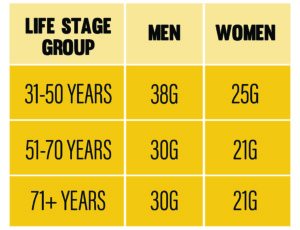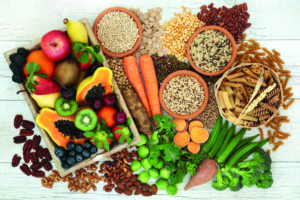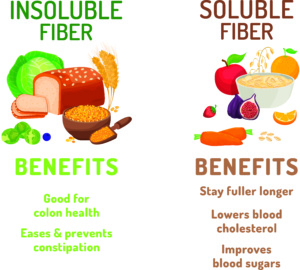What Is Fiber And
Why Do You Need It?
Article By | Michelle Dohrman, RD, LD, CNSC
What is fiber? Where can we find it? How much do we need? Fiber is a very important but underappreciated nutrient, and most people don’t know about all the wonderful benefits that fiber can provide!
Fiber is a type of carbohydrate that is only found in plant-based foods like fruits, vegetables, whole grains, beans and legumes, and nuts. It is the part of the plant that our bodies are not able to digest, and it passes right through us mostly intact. Because of this, it can offer many perks to our health.
Fiber can be either soluble or insoluble:
Soluble fiber — Dissolves in water to form a gel-like substance. It also absorbs water during digestion. Slows down digestion, making you feel full longer. Good sources include oats, peas, beans, apples, carrots, Brussels sprouts, barley, broccoli, pears, citrus fruits, etc.
Insoluble fiber — Helps to increase stool bulk and promote the stool’s movement through the GI tract, preventing constipation. Absorbs the liquid in the stomach, bulking up the food and making it take up more space, leading to faster feelings of fullness. This results in eating less at meals and snacks. Good sources include whole wheat flour, edible peels on fruits and vegetables, seeds, nuts, green beans, beans, apples, potatoes, etc.
Benefits of Fiber
Good GI Health—Fiber makes a stool bulkier and softer, making it easier to pass and preventing constipation. It also firms up a runny stool if having diarrhea. Adding more fiber may lower the risk of hemorrhoids, diverticular disease, and certain cancers, such as colon cancer.
Lowers Cholesterol Levels—Soluble fiber’s thick, gel-like consistency may block fat from being digested and dietary cholesterol from being broken down and digested.
Controls Blood Sugar—Soluble fiber slows down digestion, slowing down how quickly food turns into sugar, preventing spikes in blood sugar levels.
Lowers Risk of Heart Disease—Helps decrease cholesterol levels and fat absorption, along with stabilizing blood sugars, which can all improve cardiovascular health.
Helps Control Weight—Fiber provides bulk to food, taking up more space in the stomach, leading to feeling full faster, while also slowing down digestion. This helps to prevent over-eating.
Helps Us Live Longer—Eating more fiber may reduce the risk of many diseases, such as heart disease, diabetes, obesity, and metabolic syndrome, leading to longer, better quality lives.
 How Much Fiber Should You Eat?
How Much Fiber Should You Eat?
Most Americans consume 10-15 grams of fiber/day, about half of the Recommended Dietary Allowance (RDA). Getting adequate fiber is especially important for older adults, because their calorie requirements often decrease, making it harder to meet their nutrient needs for good health without gaining weight. Their GI tract also becomes more sluggish, so constipation is more prevalent. Adding more high-fiber foods to their diet can help older Americans eat more nutrient dense foods while keeping their weight in check. Fiber supplements may help increase fiber intake, but food is preferred since food has other health benefits not found in supplements, like vitamins and minerals.
How Can I Add More Fiber?
Adding more fiber to your diet doesn’t have to mean a major overhaul of what you eat. A few simple tweaks to what you choose can mean a big difference in your fiber intake. However, be sure to add more fiber gradually to avoid problems with gas, bloating, or stomach pains. Also, drink more fluids when you increase fiber, or you may get constipated. Fiber needs fluid to make a softer stool.
• Start your day with fiber—Eat breakfast to start your day strong with high fiber cereal, whole wheat toast, and fruit. Look for cereals and breads with “whole” as the first word on the ingredient list, NOT enriched, which has most of the fiber removed with processing.
• Make at least half of your grains whole grains— Whole wheat bread, crackers, pasta, and cereals, brown rice, barley, bulgur, and quinoa are examples of whole grains. They usually have at least 2 grams of fiber/serving. Use these in place of refined grains, like white bread or white rice, when possible, and try to eat at least 3 servings/day.
• Eat more fruits and vegetables—Sneak them in as snacks or double up at meals in place of lower fiber foods. Try to eat at least 5 servings/day of them combined. Eat the whole fruit/vegetable: juices do not have fiber.
• Add in legumes—Beans, lentils, and dried peas are all excellent sources of fiber, along with vitamins and minerals. They are inexpensive, versatile, and easy to add to a variety of foods.
• Crunch on nuts instead of chips— Satisfy your crunchy cravings with a handful of nuts instead of chips. They are more nutrient dense and more filling than processed chips.
Getting more fiber in your diet, especially as we get older, helps in keeping the GI system working properly, preventing several chronic diseases, and helping to manage weight. Adding more fiber can be as easy as making a simple change from the processed, enriched food to the whole grain option, or choosing fruit instead of cookies when craving sweets.
 Michelle has been a registered dietitian since 1990 and has worked in many areas of nutrition in the inpatient and outpatient setting. She has worked for the St. Joseph Health System at various facilities since 1999. She currently works as the dietitian for the Surgical Weight Loss program & helps to teach diabetes classes for the hospital. Michelle believes very strongly that eating good quality food influences a person’s health and quality of life and loves educating her patients about that, as well as helping them have the best life possible.
Michelle has been a registered dietitian since 1990 and has worked in many areas of nutrition in the inpatient and outpatient setting. She has worked for the St. Joseph Health System at various facilities since 1999. She currently works as the dietitian for the Surgical Weight Loss program & helps to teach diabetes classes for the hospital. Michelle believes very strongly that eating good quality food influences a person’s health and quality of life and loves educating her patients about that, as well as helping them have the best life possible.

